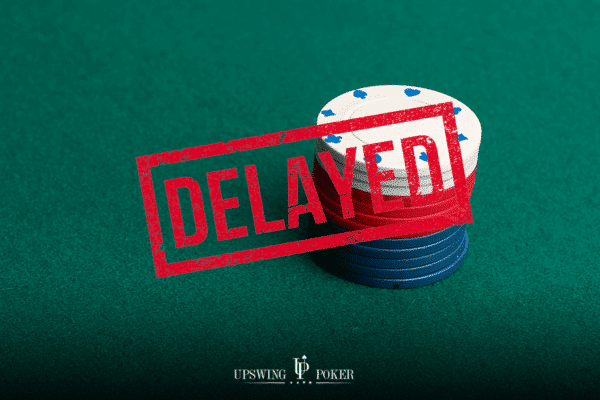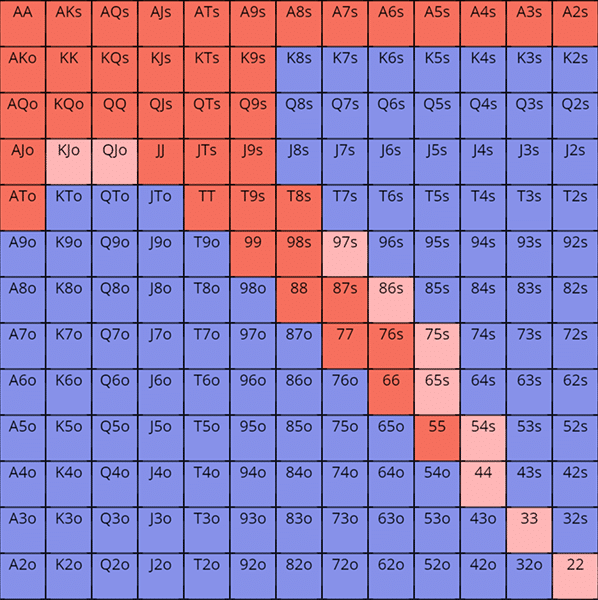조회 수 236
추천 수 0
2020.12.20 23:08:16

숙련된 포커 플레이어라면 누구든 컨티뉴에이션-벳(줄여서 C-벳)을 본인의 무기 중 하나로 갖고 있을 겁니다.
C-벳은 2가지의 결정적인 점에서 활용 되는데요:
- 일반적으로 프리플랍 어그레서가 다른 그 어떤 플레이어들보다 레인지가 가장 강함.
- 플랍에서 바로 뭔가를 맞출 확률은 그리 높지 않음. (포켓이 아닌 핸드로 플랍에서 페어를 맞출 확률은 고작 32.43%임)
하지만 요즘 C-벳은 자기가 깔아놓은 덫에 스스로 걸려버린 셈이 되어 버렸습니다. 많은 플레이어들이 C-벳을 특정 보드 텍스쳐의 플랍에서 과하게 남용하게 되면서, 공격적인 체크 레이즈와 플로팅을 당하는 익스플로잇에 쉽게 노출되어 버립니다.
자, 그러면 어떻게 하면 여러분이 c-벳을 너무 자주 하는 상황을 줄임과 동시에 프리플랍 레이저(raiser)로서의 이점을 이어갈 수 있을까요? 답은 하나입니다: 딜레이 C-벳
여기 이번 시간에 배울 내용입니다.
- "딜레이 C-벳"이란?
- 언제, 그리고 왜 딜레이 C-벳을 해야 하나요?
- 딜레이 C-벳의 예제 핸드들
"딜레이 C-벳"이란?
딜레이 C-벳들은
Delayed c-bets are when the preflop aggressor bets after the action checked through on the previous street(s). It’s an underused and often misunderstood strategy, and doing so with both made hands, draws, and bluffs will allow you to win more pots and avoid tough spots.
Working delayed c-bets into your game will have a number of benefits, including:
- Strengthening Your Checking Range
Checking back with some decent hands keeps your checking range adequately protected. By doing this, you prevent your opponents from exploiting you with an aggressive probing strategy.
- Prevents C-Betting Too Wide
As mentioned above, many players c-bet at almost every opportunity just because they have the betting initiative, which is exploitable. Delay c-betting with a portion of your range will prevent your flop c-betting range from becoming saturated with too many bluffs and/or marginal hands.
- Makes Bluffing More Effective
When your opponent calls a c-bet on the flop, their range narrows, meaning you will be up against an overall stronger range on the turn. On the other hand, when you pass up on a flop c-bet and the action checks through, ranges are wider and therefore weaker on the turn.
Being up against a weaker range makes delayed c-betting with your bluffs more effective. This is especially true when you are in position because your opponent has checked twice. When your opponent has shown weakness twice, you can be more confident with your bluffs.
When You Should Delay Your C-Bet
Here are three common situations in which you should consider a delayed c-bet rather than a c-bet.
1. When Your Hand Cannot Comfortably Bet Three Streets for Value
When you have a made hand that is not strong enough to bet all three streets for value, consider delaying your c-bet. You should mainly do this when your hand is unlikely to be outdrawn by the hands your opponent will fold on the flop.
For example:
100NL Cash Game. 100BB Effective Stacks
Hero is dealt A♠ 2♠ on the button
Hero raises to $3. Villain calls from the big blind.
Flop ($6.50) A♦ 8♣ 3♥
Villain checks.
In this flop spot, Hero’s hand is:
- Not strong enough to bet three streets for value.
- Way ahead of the range of hands that Villain will fold to a flop c-bet.
Additionally, checking back with hands like this makes Hero’s check back range stronger, allowing her to better defend against turn bets. For these reasons, Hero can check the flop with the intention of extracting value (or bluff-catching versus bets) on later streets.
When you have a made hand that is vulnerable to being outdrawn — like 8♥ 7♥ on a 7-3-2 flop — you should lean towards c-betting on the flop to deny equity. Such bets will force your opponent to fold unpaired hands that could catch up on the turn, which is win for you.
2. When Your Super Strong Hand Blocks Your Opponent’s Strong Hands
When you flop a super strong hand on a dry board, consider using a delayed c-bet. For example:
100NL Cash Game. 100BB Effective Stacks
Hero is dealt K♠ K♥ in the cutoff
Hero raises to $3. Villain calls from the big blind.
Flop ($6.50) K♦ 8♠ 2♣
Villain checks.
Hero’s top set blocks most of Villain’s strong hands on this very dry board, so checking is preferable to betting. When Hero checks, Villain will have a chance to bet on the turn as a bluff, or because he hit something.
Also, Villain is unlikely to check-raise — a dream scenario for Hero’s top set — on this dry board. If the board was more coordinated, betting with top set would be a more attractive option.
3. When You Have a Mediocre Hand on a Wet Board
If you c-bet with too many marginal hands on wet flops, your opponent can exploit you with an aggressive check-raising strategy. You simply won’t have a strong enough range to defend effectively.
You can prevent being exploited by c-betting only when you hold strong hands or hands that you don’t mind folding versus a check-raise. With a mediocre made hand, delay your c-bet until the turn or river.
Delayed C-Betting Example Hands
Now let’s dive into member-submitted hand histories with strategic commentary courtesy of Ryan Fee.
Example #1: Delayed C-Betting in a 3-Bet Pot
This hand was submitted by Lab member Sam S.
Online Cash 4-Handed. 100BB Effective Stacks.
Hero is dealt K♥ Q♦ in the small blind
Button raises to 2.3bb. Hero 3-bets to 9.5bb. Button calls.
Flop (20bb): J♠ 7♣ 6♦
Hero checks. Button checks.
Turn (20bb): 9♠
Hero bets 13bb. Button calls.
River (46bb): 4♥
Hero bets 30.33bb.
It definitely makes sense to use K♥ Q♦ as a delayed c-bet on this board. It does do a good job blocking some of the button’s strong hands (KJ/QJ), but there are many other hands in our range that are more effective c-bet bluffs. Consider our preflop range:

Red = 3-Bet, Pink = Optional 3-Bet, Blue = Fold
Note: This chart is directly from the Upswing Lab training course preflop chart viewer tool. Get access all 259 preflop charts when you join the Lab.
There are many hands in this range that have less showdown value and more playability on future streets than KQo. These include 98s, T8s, T9s, Q9s, QTs and even our KQs combos that have a backdoor flush draw. If we c-bet with these hands, plus an additional 12 combos of KQo, we run the risk of c-betting too many marginal holdings which makes our range vulnerable to raises.
On the 9♠ turn, some hands that should have checked on the flop will now be slam-dunk turn value bets (like JJ, 99 and J9). We also need to delay c-bet with bluffs in order to balance our range; using KQo makes sense because it has two overcards and turned a draw to the nuts.
I prefer a slightly smaller bet sizing on both the turn and river in this hand. Our value range consists mostly of one pair hands after checking the flop, and betting large makes less likely our opponent will continue with a worse one pair hand.
Note: Going for a mixed frequency c-bet with KQo would be a decent play here, which I’m quite sure a solver would confirm. That said, it’s fine to simplify your strategy and check every time.
Example #2: Delay C-Betting with a Marginal Value Hand in a Multiway Pot
This hand was submitted by Lab member Igor G.
25NL Cash Game. $25 Effective Stacks.
Hero is dealt A♠ T♠ in the hijack
Hero raises to $0.75. Cutoff calls. Big blind calls.
Flop ($2.35): 8♣ 5♦ A♦
Big blind checks. Hero bets $1.17. Cutoff calls. Big blind calls.
Turn ($5.86): 3♠
Big blind checks. Hero bets $2.93. Cutoff calls. Big blind folds.
River ($5.86): 4♣
Hero checks. Cutoff checks.
We should not c-bet with this hand on the flop. We have stronger top pairs (AJ+) to value bet here, along with our two-pair and set combos (88, 55, A8s, A5s). If we c-bet with weaker top pairs as well, we make ourselves vulnerable to flop raises – particularly in a multi-way pot like this.
Additionally, keeping AT in our checking range ensures that we have some relatively strong top pairs when we check. Plus, betting with AT on the flop could lead to some tricky situations if either opponent raises. When the action checks through on the flop and the turn is a blank, however, AT is an easy value bet and a great hand to have in our delayed c-betting range.
With that said, you could make a case for betting on the flop and checking on the turn with this hand. But betting both the flop and turn here is simply too thin.
Example #3: Exploiting Weak Live Players with Delay C-Bets
Upswing member Sam H. posted this hand to the Facebook group.
$2/$5 Live 9-Handed. $400 Effective Stacks.
Hero is dealt 9♦ 9♠ in middle position
UTG straddles to $10. Hero raises to $25. UTG calls.
Flop ($57): A♦ 5♠ 5♣
UTG checks. Hero checks.
Turn ($57): T♥
UTG checks. Hero checks.
River ($57): J♥
UTG checks. Hero checks.
Since this is a live hand, I’m going to recommend a highly exploitative delayed c-betting strategy that has printed money for me at live tables.
A common tendency of live players is to bet any pair on the turn after the flop has checked through. I think they do it for “protection”, or because they fear facing a turn bet themselves. Either way, this tendency is a massive leak that can be exploited with an aggressive delayed c-betting strategy.
On this board, such opponents would lead on the turn with all of the Ax, Tx and 5x combos in their range. If this is the case, we can delayed c-bet on the turn with an astronomically high success rate. We can also check back more hands that we would normally c-bet on the flop in order to reach this very profitable turn spot more often.
These types of players are most common in live games, but this adjustment will work well against anyone that probe bets too liberally.
Final Thoughts
If you read every word of this article, congrats because you covered a lot of ground in a short time. To recap the main points:
- Delayed c-betting is when you bet on the turn after passing up a c-bet opportunity on the flop.
- The benefits of delayed c-betting include:
- Strengthening your checking range.
- Keeping your c-bet frequency under control.
- Making your bluffs more effective.
- Situations in which you should delay your c-bet include:
- When your not-so-vulnerable made hand cannot comfortably bet three streets for value.
- When your super strong hand blocks your opponent’s strong hands.
- When you have a mediocre hand on a wet board.
To quiz yourself on this topic, check out “[QUIZ] Do You Actually Know When to Delay C-Bet?“
Thanks for reading!
스크랩
댓글 수
0
댓글 작성은 로그인이 필요합니다.
클릭 시 로그인페이지로 이동합니다.








